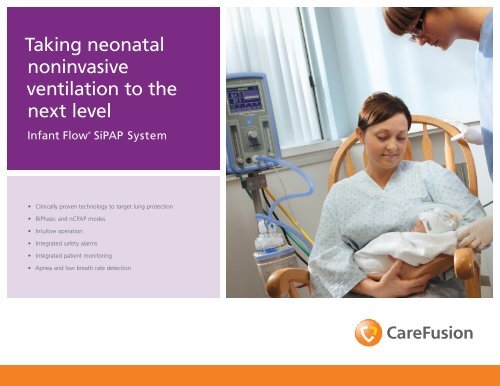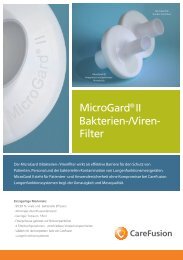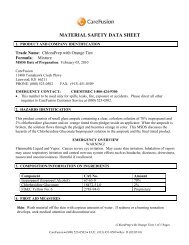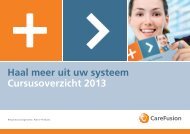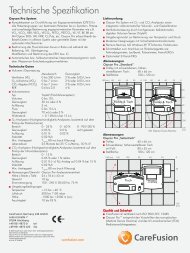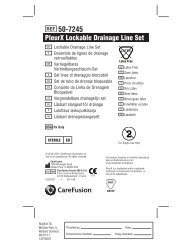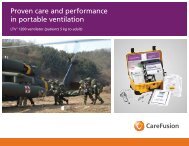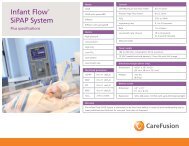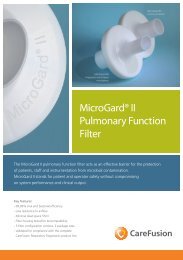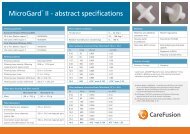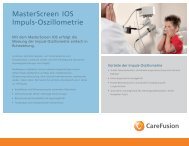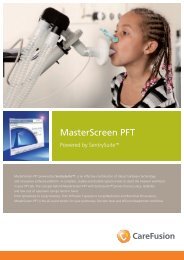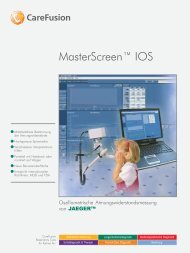SiPAP Brochure - CareFusion
SiPAP Brochure - CareFusion
SiPAP Brochure - CareFusion
You also want an ePaper? Increase the reach of your titles
YUMPU automatically turns print PDFs into web optimized ePapers that Google loves.
Taking neonatal<br />
noninvasive<br />
ventilation to the<br />
next level<br />
Infant Flow ®<br />
<strong>SiPAP</strong> System<br />
• Clinically proven technology to target lung protection<br />
• BiPhasic and nCPAP modes<br />
• Intuitive operation<br />
• Integrated safety alarms<br />
• Integrated patient monitoring<br />
• Apnea and low breath rate detection
Advancements in noninvasive therapy<br />
The Infant Flow <strong>SiPAP</strong> System is clinically proven 1 in the successful treatment<br />
of thousands of patients worldwide. The Infant Flow <strong>SiPAP</strong> System,<br />
combined with the patented generator technology designed specifically for<br />
infants, provides a complete solution for noninvasive ventilatory support.<br />
The Infant Flow <strong>SiPAP</strong> System offers a comprehensive selection of modalities<br />
to provide noninvasive ventilatory support to your neonatal patient. These<br />
modalities present the clinician with treatment options to protect the<br />
neonate’s fragile lungs.<br />
Clinically proven technology<br />
• Reduced ventilator days and extubation failures 2<br />
• Improved oxygenation and ventilation in BiPhasic mode 2<br />
• Improved treatment of apnea of prematurity 3<br />
• Provides maximum pressure stability at the lowest work of breathing 4<br />
Advanced noninvasive treatment options<br />
• Choice of CPAP, BiPhasic or BiPhasic trigger (tr)*<br />
• Use of grasby capsule for apnea detection and patient synchronization<br />
in BiPhasic tr*<br />
• Apnea and low breath rate detection, and patient synchronization in<br />
BiPhasic tr*<br />
Safe and versatile<br />
• Up to two hours of battery back up<br />
• Simple Touch operation facilitates ease of use<br />
• Fully integrated patient monitoring for easy patient assessment<br />
• Fully integrated alarm systems for patient safety<br />
*Not available in the United States
Protecting fragile lungs<br />
nCPAP<br />
Nasal CPAP (nCPAP) is a constant, stable, single level of positive<br />
pressure to the infant’s airways; facilitating the restoration of<br />
functional residual capacity and the correction of hypoxemia.<br />
nCPAP is an established method for providing noninvasive<br />
respiratory support to a spontaneously breathing infant via a nasal<br />
mask or nasal prongs.<br />
BiPhasic mode<br />
BiPhasic mode is a timed pressure rise<br />
above baseline CPAP. Small incremental<br />
pressure increases of 2-3 cmH 2 O augment<br />
functional residual capacity and can<br />
offload respiratory work of breathing.<br />
BiPhasic mode has been shown to<br />
improve oxygenation and ventilation 2<br />
when compared to CPAP.<br />
Inspiratory flow<br />
Expiratory flow<br />
Inspiratory flow<br />
The flow provided by the Infant Flow <strong>SiPAP</strong> System is accelerated<br />
in the twin injector nozzles of the Infant Flow Generator. When<br />
the patient makes a spontaneous inspiratory effort, the Infant Flow<br />
Generator converts the kinetic energy of the flow to pressure,<br />
thereby reducing the work of breathing for the patient and<br />
maximizing pressure stability at the patient interface.<br />
BiPhasic trigger (tr)*<br />
BiPhasic tr is a noninvasive<br />
synchronized nasal intermittent positive<br />
pressure ventilatory (SNIPPV) support<br />
modality that allows clinicians to<br />
provide respiratory support without the<br />
need for an endotracheal tube. SNIPPV<br />
decreases ventilator days by giving<br />
the clinician the ability to potentially<br />
prevent intubation or the option to<br />
extubate early, therefore decreasing the<br />
risks associated with intubation.<br />
Advanced monitoring<br />
Expiratory flow<br />
When the infant exhales, there is a decrease in the forward velocity<br />
of the air flow. This allows for the “flip” of gas flow from the nasal<br />
prongs to the expiratory tube. The residual gas pressure is provided<br />
by the continuous gas flow, which enables a stable CPAP pressure<br />
delivery throughout the respiratory cycle. When expiratory effort<br />
stops, the flow instantly flips back to the inspiratory position.<br />
Monitoring screen<br />
Graphical waveform screen<br />
*Not available in the United States
References<br />
1 Migliori C, Motta M, Angeli A, Chirico G. Nasal Bilevel vs Continuous Positive Airway Pressure in Preterm Infants. Pediatric<br />
Pulmonology. 2005; 40:426-430.<br />
2 Lista G, Castoldi F, Fontana P, Daniele I, Cavigioli F Rossi S. Mancuso D, Reali R. Nasal continuous positive airway pressure (CPAP)<br />
versus bi-level nasal CPAP in preterm babies with respiratory distress syndrome: a randomized control trial. Arch Dis Child Fetal<br />
Neonatal Ed. 2010 Mar; 95(2)F85-9.<br />
3 Pantalitschka T, Sievers J, Urschitz MS, Herberts T, Reher C, Poets C. Randomised crossover trial of four nasal respiratory support<br />
systems for apnoea of prematurity in very low birthweight infants. Arch Dis Child Fetal Neonatal Ed. 2009 Jul; 94(4):F245-8.<br />
4 Aghai ZH, Saslow JG, Nakhla T, Milcarek B, Hart J, Lawrysh-Plunkett R, Stahl G, Habib RH, Pvon KH. Synchronized nasal intermittent<br />
positive pressure ventilation (SNIPPV) decreases work of breathing (WOB) in premature infants with respiratory distress syndrome<br />
(RDS) compared to nasal continuous positive airway pressure (NCPAP). Pediatr Pulmonol 2006 Sept; 41(9):875-81.<br />
<strong>CareFusion</strong><br />
22745 Savi Ranch Parkway<br />
Yorba Linda, CA 92887<br />
800.231.2466 toll-free<br />
714.283.2228 tel<br />
714.283.8493 fax<br />
<strong>CareFusion</strong> Germany 234 GmbH<br />
Leibnizstrasse 7<br />
97204 Hoechberg<br />
Germany<br />
+49 931 4972-0 tel<br />
+49 931 4972-423 fax<br />
<strong>CareFusion</strong><br />
Yorba Linda, CA<br />
carefusion.com<br />
© 2010 <strong>CareFusion</strong> Corporation or one of its subsidiaries. All rights reserved. Infant Flow and Simple Touch are trademarks or registered trademarks of<br />
<strong>CareFusion</strong> Corporation or one of its subsidiaries. All other trademarks are property of their respective owners. RC1797 (0910/4000)<br />
L2834-101 Rev. B


